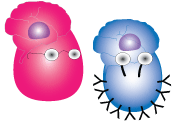
Introduction
In the last section you learned how lymphocytes specifically recognise antigens, how their individual receptors are made, how during this production process enormous diversity is created resulting in each lymphocyte having a different antigen specificity, and how the lymphocytes develop, both before they encounter antigen in the thymus and bone marrow, and after they have encountered antigen in the secondary lymphoid organs. In the following sections we will look more closely at how these lymphocytes react during antigen encounter, resulting in their activation and what activated B and T cells do. We will start with the T lymphocytes, but before we dive into the world of T cell activation and differentiation, let's take a moment to summarise what we already know about T cells.
T cells are lymphocytes that are born in the bone marrow and educated in the thymus where positive and negative selection gives us mature T cells that recognise MHC molecules (positive selection) with foreign peptide (negative selection of T cells that recognise self-peptides). These T cells leave the thymus not yet having encountered the antigen they are specific for and hence are called naïve cells. We have different kinds of T cells; CD4+ helper T cells that release lots of cytokines when activated and CD8+ killer T cells that are assassins ready to kill target cells simply by touching them. We also have regulatory T cells that can suppress immune responses, but let's stay with the helper and killer T cells for a moment, as I want to ask you if you know how and why some T cells turn out to be CD4+ helper cells, whereas others turn into CD8+ assassins? Can you remember the video on the lymphocyte development page where they talk about the fact that all thymocytes start out carrying both the CD4 and the CD8 co-receptors? Why was expression of one of the co-receptors lost? To figure this out, compare the binding sites of CD4 to MHC class II and CD8 to MHC class I in the magnifying glasses in the graphic. Can you see that CD4 is binding to an area on MHC class II that is not present at all in MHC class I? A T cell with a TCR that is recognising a foreign peptide in MHC class II can therefore only use CD4 as a co-receptor and will drop its expression of CD8 and develop into a helper T cell, whereas a T cell with a TCR that is recognising a foreign peptide in MHC class I can only use CD8 as co-receptor and will develop into a killer T cell. So what makes these helper and killer T cells tick and what do they do? Let's find out in the next few pages!